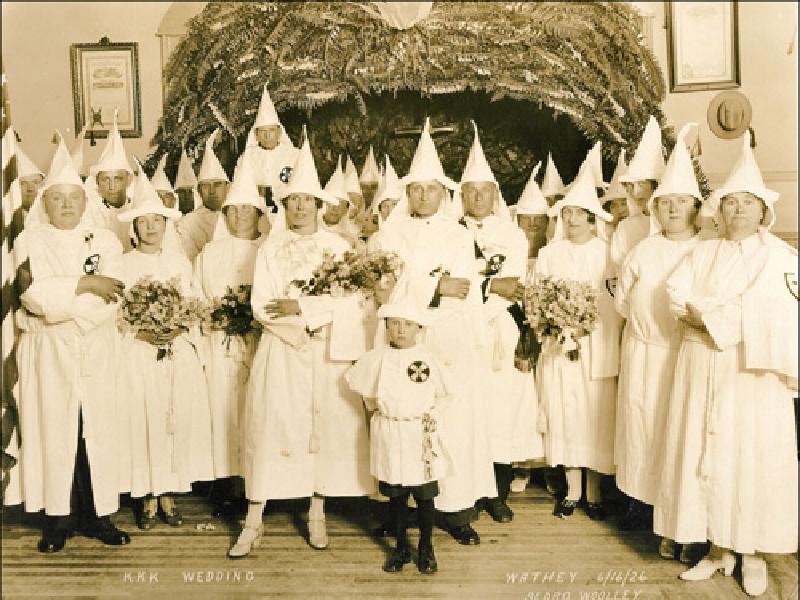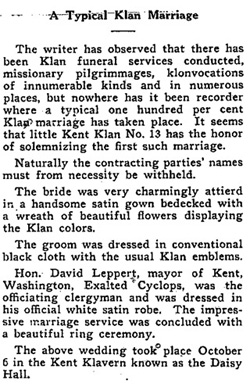

Imagine wearing a Klan robe for a wedding dress, and having the Imperial Cyclops of the local Klan, who also happens to be the Mayor, officiate your marriage before your family and friends, who are also wearing Klan robes. Or celebrating Christmas by having your child sit on the lap of jolly “Kris Kringle,” the King Kleagle of the local Klan domain, and sing carols next to a Christmas tree “lighted by a Fiery Cross.”
These were just some of the innovations that the Ku Klux Klan sought to introduce to its members in the Pacific Northwest during the 1920s. And while such rituals were rare even among most Klansmen, and never gained popularity (most notably in a failed “Klan Frolic” in Portland staged by Luther I. Powell), they show how the Klan sought to insinuate itself into people’s everyday lives.
On the one hand, the Klan attempted to transform some of the most sacred activities in American life at the time. It treated activities which most people viewed in religious terms as political acts that needed to include self-conscious displays of patriotism and white supremacy.
The above photo of a “KKK Wedding” in Sedro Woolley in 1926 highlights this point by showing how the Klan sought to link family, religion (notice the cross in the hearth), the flag, and one’s membership in civic groups like the Modern Woodmen of America (notice the certificate in the top left of the photo; KKK leader William J. Simmons was also a Woodman). Though these pairings may seem stranger in retrospect, an article from the Bellingham Herald just two months later showed how easily they could be taken for granted. In its story, “Klan Wedding Held: Nooksack Couple Married at Tulip Hall Here” the Herald reported the wedding as a family event with only pro forma mention that it was held “in the presence of klansmen and invited guests.”
On the other hand, unusual rituals like the Klan wedding and Klan Christmas showed the shameless depths to which Ku Klux Klan marketing could go. The Klan recruited members by marketing itself as a means to celebrate and support that which most white Americans did already: go to church, get involved in civic groups and fraternal orders, participate in family life, and vote. The Klan would capitalize on people’s insecurity that these activities were under threat from within and without, and offer itself (for a fee) as a kind of protector of tradition. The ultimate goal of such marketing was to transform people’s everyday habits so they came to think that being American was synonymous with being a Klan member. Conversely, in its attempts to politicize people’s private lives, the Klan sought to define as un-American those who had different cultures, different religions, different skin color, and different sexualities.
So while the incorporation of Klan symbols into people’s everyday lives may seem absurd in retrospect, their strangeness can also make us more aware of how hate groups have sought to politicize marriage and religion to make certain private practices the bedrock of what is supposed to be “American.”
Next: Ch 8, The Washington State KKK and the U.S. Navy
“The Washington State Klan in the 1920s” by Trevor Griffey includes the following chapters:
- Citizen Klan: Electoral Politics and the KKK in WA
- Luther I. Powell, Northwest KKK Organizer
- The Ku Klux Klan in Seattle
- The Strongest Chapter in WA: Bellingham’s KKK
- The Ku Klux Klan and Vigilante Culture in Yakima Valley
- KKK Super Rallies in Washington State, 1923-24
- Social Klan: White Supremacy in Everyday Life
- The Washington State KKK and the U.S. Navy
- Non-Citizen Klan: Royal Riders of the Red Robe
Copyright (©) Trevor Griffey 2007


